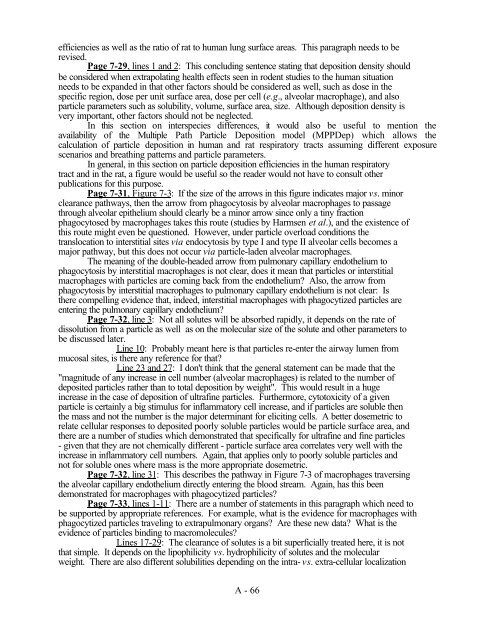Review of the Air Quality Criteria Document for Particulate Matter
Review of the Air Quality Criteria Document for Particulate Matter
Review of the Air Quality Criteria Document for Particulate Matter
- No tags were found...
You also want an ePaper? Increase the reach of your titles
YUMPU automatically turns print PDFs into web optimized ePapers that Google loves.
efficiencies as well as <strong>the</strong> ratio <strong>of</strong> rat to human lung surface areas. This paragraph needs to berevised.Page 7-29, lines 1 and 2: This concluding sentence stating that deposition density shouldbe considered when extrapolating health effects seen in rodent studies to <strong>the</strong> human situationneeds to be expanded in that o<strong>the</strong>r factors should be considered as well, such as dose in <strong>the</strong>specific region, dose per unit surface area, dose per cell (e.g., alveolar macrophage), and alsoparticle parameters such as solubility, volume, surface area, size. Although deposition density isvery important, o<strong>the</strong>r factors should not be neglected.In this section on interspecies differences, it would also be useful to mention <strong>the</strong>availability <strong>of</strong> <strong>the</strong> Multiple Path Particle Deposition model (MPPDep) which allows <strong>the</strong>calculation <strong>of</strong> particle deposition in human and rat respiratory tracts assuming different exposurescenarios and breathing patterns and particle parameters.In general, in this section on particle deposition efficiencies in <strong>the</strong> human respiratorytract and in <strong>the</strong> rat, a figure would be useful so <strong>the</strong> reader would not have to consult o<strong>the</strong>rpublications <strong>for</strong> this purpose.Page 7-31, Figure 7-3: If <strong>the</strong> size <strong>of</strong> <strong>the</strong> arrows in this figure indicates major vs. minorclearance pathways, <strong>the</strong>n <strong>the</strong> arrow from phagocytosis by alveolar macrophages to passagethrough alveolar epi<strong>the</strong>lium should clearly be a minor arrow since only a tiny fractionphagocytosed by macrophages takes this route (studies by Harmsen et al.), and <strong>the</strong> existence <strong>of</strong>this route might even be questioned. However, under particle overload conditions <strong>the</strong>translocation to interstitial sites via endocytosis by type I and type II alveolar cells becomes amajor pathway, but this does not occur via particle-laden alveolar macrophages.The meaning <strong>of</strong> <strong>the</strong> double-headed arrow from pulmonary capillary endo<strong>the</strong>lium tophagocytosis by interstitial macrophages is not clear, does it mean that particles or interstitialmacrophages with particles are coming back from <strong>the</strong> endo<strong>the</strong>lium? Also, <strong>the</strong> arrow fromphagocytosis by interstitial macrophages to pulmonary capillary endo<strong>the</strong>lium is not clear: Is<strong>the</strong>re compelling evidence that, indeed, interstitial macrophages with phagocytized particles areentering <strong>the</strong> pulmonary capillary endo<strong>the</strong>lium?Page 7-32, line 3: Not all solutes will be absorbed rapidly, it depends on <strong>the</strong> rate <strong>of</strong>dissolution from a particle as well as on <strong>the</strong> molecular size <strong>of</strong> <strong>the</strong> solute and o<strong>the</strong>r parameters tobe discussed later.Line 10: Probably meant here is that particles re-enter <strong>the</strong> airway lumen frommucosal sites, is <strong>the</strong>re any reference <strong>for</strong> that?Line 23 and 27: I don't think that <strong>the</strong> general statement can be made that <strong>the</strong>"magnitude <strong>of</strong> any increase in cell number (alveolar macrophages) is related to <strong>the</strong> number <strong>of</strong>deposited particles ra<strong>the</strong>r than to total deposition by weight". This would result in a hugeincrease in <strong>the</strong> case <strong>of</strong> deposition <strong>of</strong> ultrafine particles. Fur<strong>the</strong>rmore, cytotoxicity <strong>of</strong> a givenparticle is certainly a big stimulus <strong>for</strong> inflammatory cell increase, and if particles are soluble <strong>the</strong>n<strong>the</strong> mass and not <strong>the</strong> number is <strong>the</strong> major determinant <strong>for</strong> eliciting cells. A better dosemetric torelate cellular responses to deposited poorly soluble particles would be particle surface area, and<strong>the</strong>re are a number <strong>of</strong> studies which demonstrated that specifically <strong>for</strong> ultrafine and fine particles- given that <strong>the</strong>y are not chemically different - particle surface area correlates very well with <strong>the</strong>increase in inflammatory cell numbers. Again, that applies only to poorly soluble particles andnot <strong>for</strong> soluble ones where mass is <strong>the</strong> more appropriate dosemetric.Page 7-32, line 31: This describes <strong>the</strong> pathway in Figure 7-3 <strong>of</strong> macrophages traversing<strong>the</strong> alveolar capillary endo<strong>the</strong>lium directly entering <strong>the</strong> blood stream. Again, has this beendemonstrated <strong>for</strong> macrophages with phagocytized particles?Page 7-33, lines 1-11: There are a number <strong>of</strong> statements in this paragraph which need tobe supported by appropriate references. For example, what is <strong>the</strong> evidence <strong>for</strong> macrophages withphagocytized particles traveling to extrapulmonary organs? Are <strong>the</strong>se new data? What is <strong>the</strong>evidence <strong>of</strong> particles binding to macromolecules?Lines 17-29: The clearance <strong>of</strong> solutes is a bit superficially treated here, it is notthat simple. It depends on <strong>the</strong> lipophilicity vs. hydrophilicity <strong>of</strong> solutes and <strong>the</strong> molecularweight. There are also different solubilities depending on <strong>the</strong> intra- vs. extra-cellular localizationA - 66
















